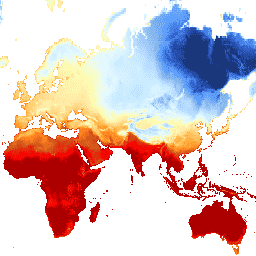Page Summary
-
TerraClimate is a monthly climate and climatic water balance dataset for global land surfaces available from 1958 to present.
-
The dataset combines high-resolution climate normals with time-varying data to create a spatially detailed record covering a broad temporal range.
-
TerraClimate also provides monthly surface water balance datasets derived from a water balance model incorporating various climate factors.
-
The data has limitations including inherited long-term trends, inability to capture fine-scale temporal variability, a simple water balance model, and limited validation in data-sparse regions.
-
The dataset includes bands for various climate variables such as temperature, precipitation, evapotranspiration, drought index, and more.

- Dataset Availability
- 1958-01-01T00:00:00Z–2024-12-01T00:00:00Z
- Dataset Provider
- University of California Merced
- Cadence
- 1 Month
- Tags
Description
TerraClimate is a dataset of monthly climate and climatic water balance for global terrestrial surfaces. It uses climatically aided interpolation, combining high-spatial resolution climatological normals from the WorldClim dataset, with coarser spatial resolution, but time-varying data from CRU Ts4.0 and the Japanese 55-year Reanalysis (JRA55). Conceptually, the procedure applies interpolated time-varying anomalies from CRU Ts4.0/JRA55 to the high-spatial resolution climatology of WorldClim to create a high-spatial resolution dataset that covers a broader temporal record.
Temporal information is inherited from CRU Ts4.0 for most global land surfaces for temperature, precipitation, and vapor pressure. However, JRA55 data is used for regions where CRU data had zero climate stations contributing (including all of Antarctica, and parts of Africa, South America, and scattered islands). For primary climate variables of temperature, vapor pressure, and precipitation, the University of Idaho provides additional data on the number of stations (between 0 and 8) that contributed to the CRU Ts4.0 data used by TerraClimate. JRA55 was used exclusively for solar radiation and wind speeds.
TerraClimate additionally produces monthly surface water balance datasets using a water balance model that incorporates reference evapotranspiration, precipitation, temperature, and interpolated plant extractable soil water capacity. A modified Thornthwaite-Mather climatic water-balance model and extractable soil water storage capacity data was used at a 0.5° grid from Wang-Erlandsson et al. (2016).
Data Limitations:
Long-term trends in data are inherited from parent datasets. TerraClimate should not be used directly for independent assessments of trends.
TerraClimate will not capture temporal variability at finer scales than parent datasets and thus is not able to capture variability in orographic precipitation ratios and inversions.
The water balance model is very simple and does not account for heterogeneity in vegetation types or their physiological response to changing environmental conditions.
Limited validation in data-sparse regions (e.g., Antarctica).
Bands
Pixel Size
4638.3 meters
Bands
| Name | Units | Min | Max | Scale | Pixel Size | Description |
|---|---|---|---|---|---|---|
aet |
mm | 0* | 3140* | 0.1 | meters | Actual evapotranspiration, derived using a one-dimensional soil water balance model |
def |
mm | 0* | 4548* | 0.1 | meters | Climate water deficit, derived using a one-dimensional soil water balance model |
pdsi |
-4317* | 3418* | 0.01 | meters | Palmer Drought Severity Index |
|
pet |
mm | 0* | 4548* | 0.1 | meters | Reference evapotranspiration (ASCE Penman-Montieth) |
pr |
mm | 0* | 7245* | meters | Precipitation accumulation |
|
ro |
mm | 0* | 12560* | meters | Runoff, derived using a one-dimensional soil water balance model |
|
soil |
mm | 0* | 8882* | 0.1 | meters | Soil moisture, derived using a one-dimensional soil water balance model |
srad |
W/m^2 | 0* | 5477* | 0.1 | meters | Downward surface shortwave radiation |
swe |
mm | 0* | 32767* | meters | Snow water equivalent, derived using a one-dimensional soil water balance model |
|
tmmn |
°C | -770* | 387* | 0.1 | meters | Minimum temperature |
tmmx |
°C | -670* | 576* | 0.1 | meters | Maximum temperature |
vap |
kPa | 0* | 14749* | 0.001 | meters | Vapor pressure |
vpd |
kPa | 0* | 1113* | 0.01 | meters | Vapor pressure deficit |
vs |
m/s | 0* | 2923* | 0.01 | meters | Wind-speed at 10m |
Image Properties
Image Properties
| Name | Type | Description |
|---|---|---|
| status | STRING | 'provisional' or 'permanent' |
Terms of Use
Terms of Use
The data set is in the public domain as licensed under the Creative Commons Public Domain (CC0) license.
Citations
Abatzoglou, J.T., S.Z. Dobrowski, S.A. Parks, K.C. Hegewisch, 2018, Terraclimate, a high-resolution global dataset of monthly climate and climatic water balance from 1958-2015, Scientific Data 5:170191, doi:10.1038/sdata.2017.191
Explore with Earth Engine
Code Editor (JavaScript)
var dataset = ee.ImageCollection('IDAHO_EPSCOR/TERRACLIMATE') .filter(ee.Filter.date('2017-07-01', '2017-08-01')); var maximumTemperature = dataset.select('tmmx'); var maximumTemperatureVis = { min: -300.0, max: 300.0, palette: [ '1a3678', '2955bc', '5699ff', '8dbae9', 'acd1ff', 'caebff', 'e5f9ff', 'fdffb4', 'ffe6a2', 'ffc969', 'ffa12d', 'ff7c1f', 'ca531a', 'ff0000', 'ab0000' ], }; Map.setCenter(71.72, 52.48, 3); Map.addLayer(maximumTemperature, maximumTemperatureVis, 'Maximum Temperature');
import ee import geemap.core as geemap
Colab (Python)
dataset = ee.ImageCollection('IDAHO_EPSCOR/TERRACLIMATE').filter( ee.Filter.date('2017-07-01', '2017-08-01') ) maximum_temperature = dataset.select('tmmx') maximum_temperature_vis = { 'min': -300.0, 'max': 300.0, 'palette': [ '1a3678', '2955bc', '5699ff', '8dbae9', 'acd1ff', 'caebff', 'e5f9ff', 'fdffb4', 'ffe6a2', 'ffc969', 'ffa12d', 'ff7c1f', 'ca531a', 'ff0000', 'ab0000', ], } m = geemap.Map() m.set_center(71.72, 52.48, 3) m.add_layer( maximum_temperature, maximum_temperature_vis, 'Maximum Temperature' ) m